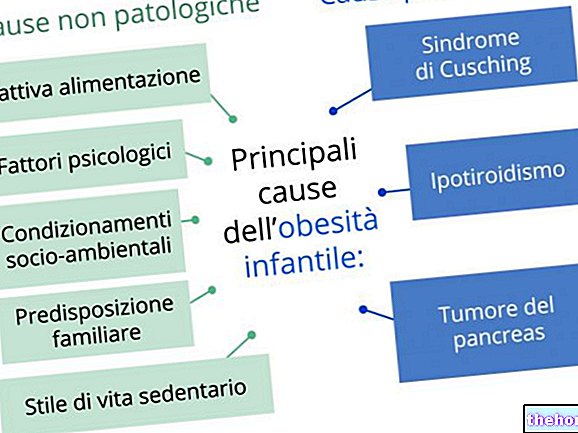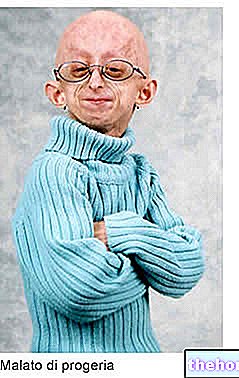Generality
Infantile cerebral palsy is a neurological disorder that mainly affects motor skills and muscle tone.

The symptoms of infantile cerebral palsy are very varied and each patient represents a case in itself; this variability depends on the extent of brain damage, which can only be measured by radiological tests (CT and nuclear magnetic resonance).
Although there is no possibility of recovery, therapeutic countermeasures can be put into practice that can improve the symptoms and standard of living of patients.
What is infantile cerebral palsy?
Infantile cerebral palsy is a persistent, non-progressive neurological disorder that impairs a child's movement coordination, posture, tone and mastery of skeletal muscles, space perception, and communication skills.
EPIDEMIOLOGY
According to some British statistics, one in every 400 newborns is born with infantile cerebral palsy.
As will also be seen in the chapter dedicated to the causes, the most affected are those born prematurely (40-50% of cases) and those who have an extremely low birth weight (6% of cases).
70-90% of children with infantile cerebral palsy developed the disorder before birth.
Causes
Infantile cerebral palsy occurs after an insult to the brain - suffered by the patient before, during or after birth - has blocked its normal development and damaged part of its nervous structure.
But what exactly causes this damage?
At one time, it was believed that infantile cerebral palsy was uniquely linked to an episode of asphyxiation in the child during childbirth.Since the 1980s, however, numerous scientific studies conducted in this regard have demonstrated the existence of other risk factors, which occur more frequently before the birth of the child.
Here is a list and brief description of potentially dangerous situations:
- A genetic mutation in one or more genes involved in brain development.
- A health disorder of the mother during pregnancy; disorder that can be represented by a "viral or bacterial infection that is transmitted to the fetus, by a thyroid problem, by contact with toxic material, etc."
- A fetal stroke, which is a "disruption of blood flow to the baby's brain (both before and after birth).
- A shortage of oxygen to the brain compartment (asphyxia), which arises from a problematic labor or delivery.
- A "fetal infection, which affects the baby's brain after birth, or a condition of severe jaundice (always after birth).
- A brain trauma, to the detriment of the child. Examples of trauma are those caused by a fall from the bed or from the bicycle seat.
- Premature birth: it is considered as such when it occurs before the 37th week of gestation. According to a "statistical survey, all those born before the 32nd week are at high risk.
- Low birth weight: High-risk babies are those who weigh between 1 and 1.5 kilograms.
- Breech birth, that is when the baby, at birth, presents itself with the feet, rather than with the head.
Below, some aspects relating to the health disorders of the mother and child will be explored.

Figure: When pregnant, beware of viral or bacterial infections: some may affect the fetus.
MATERNAL HEALTH DISORDERS
Maternal infections associated with infantile cerebral palsy are:
- Rubella. Caused by a virus, there is an effective vaccine.
- Chickenpox. It is a "viral type of infection, which can be prevented with a vaccine.
- Cytomegalovirus. This viral infection causes symptoms similar to those of the flu, but unlike this it can cause serious problems for the fetus (not just infantile cerebral palsy).
- Toxoplasmosis. It is caused by a parasite that is usually found in contaminated food or in the feces of infected cats.
- Syphilis. It is a "bacterial infection, sexually transmitted.
In addition, exposure to methylmercury, thyroid problems, arterial hypertension and recurrent attacks of epilepsy are favorable situations.
INFECTIONS AND OTHER DISORDERS IN THE CHILD
The newborn is at risk of infantile cerebral palsy if he has one of the following conditions: bacterial meningitis, viral encephalitis, or severe (or untreated) jaundice.
Bacterial meningitis is an "inflammation of the meninges, the membranes that surround the brain and spinal cord.
Viral encephalitis is an inflammation of the brain matter and spinal cord.
Finally, severe jaundice is a pathological condition in which bilirubin accumulates in the tissues due to its lack of disposal; the classic sign of jaundice is the patient's yellow color.
Symptoms and Complications
For further information: Infantile Cerebral Palsy Symptoms
Each patient, suffering from infantile cerebral palsy, represents a separate case, as the symptoms and signs depend on the severity and extent of the cerebral insult. In other words, the greater the damage to the brain, the greater the number of impaired brain functions.
The lack of coordination in movements and the altered mastery of skeletal muscles are, by far, the most characteristic manifestations of the disease; moreover, the symptomatological picture can be complicated by many other disorders, from those of learning and communicative faculties to those of sight. and ingestion of food.
Below is a complete account of the symptoms that can characterize infantile cerebral palsy:
- Reduced muscle tone. Muscle mass weakens (muscle hypotonia) and takes on a limp appearance.
- Muscle spasticity, characterized by exaggerated tendon reflexes.
- Muscle stiffness.
- Lack of motor coordination (ataxia).
- Hand tremors or involuntary movements (for example, strange facial gestures).
- Slow twisting movements (athetosis).
- Delay or difficulty in learning to grip objects, to stand up unaided and to crawl.
- Difficult walking: the typical gait is that on the tips, also called scissor gait.
- Excessive drooling, difficulty chewing and swallowing (dysphagia), problems with speech and speaking clearly (dysarthria). All these disorders are due to lack of control and hypotonia of the muscles of the mouth and tongue.
- Posture problems and spinal malformations, mainly due to poor muscle tone.
- Lack of hearing and sight; impaired perception of depth.
- Epilepsy.
- Mental disorders and poor learning.
- Urinary incontinence.
Some frequently asked questions
- When do the symptoms appear?
Symptoms usually appear within the first three years of life. - Do the symptoms affect one side of the body or both?
It depends on the extent of the damage that the brain has suffered. If the insults are extended to both cerebral hemispheres, then the symptoms appear on both sides of the body. Conversely, if the insult is limited to one of the hemispheres, the signs of infantile cerebral palsy can only be seen on one side. - Is it a progressive disease?
Infantile cerebral palsy is a persistent but not progressive neurological disorder; therefore, it does not get worse over time. However, this does not exclude the possibility of complications due to poor muscle tone and lack of motor coordination.
COMPLICATIONS

They are mainly due to poor muscle tone, spasticity and lack of motor coordination.
The most important complications are muscle contractures: these, in the long run, hinder normal bone growth, deform the joints and cause arthrosis.
To follow, there are: malnutrition, especially when chewing and swallowing difficulties are considerable, and scoliosis, caused by an inadequate and weak trunk musculature.
Diagnosis
If the conditions exist for a child to be affected by cerebral palsy, the first diagnostic check to be carried out is a thorough physical examination.
After that, the situation is definitively clarified by a series of specific checks on the brain (radiological examinations and electroencephalogram) and by laboratory tests.
OBJECTIVE EXAMINATION
During the physical examination, the doctor thoroughly analyzes the entire symptomatology and, together with the mother, investigates the clinical history of the little patient, from before birth to the moment of delivery, to the days immediately following. For example, for what has been said about risk factors, for diagnostic purposes it may be essential to know if the birth was premature, if the baby weighed very little at birth, if there was a viral or bacterial infection to the detriment of the mother. etc. This information is very often more important than all the various radiological and laboratory tests.
RADIOLOGICAL EXAMINATIONS
The radiological images show the health conditions of the brain and which areas of the organ are actually damaged. Furthermore, they are very important for the purposes of differential diagnosis, ie in the exclusion of pathologies similar to the one suspected.
The exams consist of:
- Nuclear magnetic resonance (MRI): it is an examination that is not harmful to the health of the child, which takes place in one "hour and shows the locations of the various brain anomalies.
- Computed Axial Tomography (CT): takes about 20 minutes and can show brain insults. It uses low doses of harmful ionizing radiation.
- Brain ultrasound: of the three, it is the least reliable. It takes place for its speed and for its non-invasiveness.
EEG (EEG)
The EEG measures the brain's electrical activity by means of electrodes placed on the patient's head. Often, this examination is used when the patient, with suspected infantile cerebral palsy, exhibits seizures of epilepsy.
LABORATORY EXAMS
Blood tests (from classic ones to genetic tests) are used by the doctor to exclude or not the possibility that the disorders are due to blood coagulation pathologies or congenital genetic diseases.
OTHER CHECKS
Based on the symptoms manifested by the patient, it is possible to carry out a long series of additional investigations, which concern sight, hearing, language skills, intellectual faculties, motor coordination, etc. The purpose is to evaluate the entity. of the problem in order to plan the right treatment.
Treatment
Because the brain injury cannot be repaired, infantile cerebral palsy is not curable.
However, therapeutic countermeasures are available, able to improve symptoms (and consequently also the standard of living) and slow down the onset of complications. These treatments are mainly on a pharmacological and physiotherapeutic basis, although surgery should not be excluded. (in severe cases), occupational therapy and speech therapy.
Once the pathology has been diagnosed, parents of patients are advised to entrust their child to a team of doctors and experts in the field, to guarantee him the best care (from childhood to adulthood).
PHARMACOLOGICAL TREATMENT
Pharmacological treatment aims to improve disorders related to muscle spasticity and stiffness.
Side Effects of Botox:
- Redness, itching and pain at the injection site
- Headache
- Muscle weakness
- Respiratory difficulties
The choice of the most suitable drugs depends on which and how many muscles are involved.
If the spasticity is isolated to a group of muscles, the doctor will prescribe injections of Botox (botulinum toxin), directly in the affected area. oral administrations of:
- Diazepam. Prolonged use is not recommended, as it could cause addiction. Side effects are sleepiness and tiredness.
- Dantrolene. It can cause the following side effects: nausea, diarrhea and drowsiness.
- Baclofen. Its side effects are: sleepiness, confusion and nausea.
Other drugs used:
- Scopolamine
- Glycopyrrolate
- Triesiphenidyl

Figure: some aids for children's walking
PHYSIOTHERAPY
The purpose of physiotherapy is to improve the muscle strength and elasticity, joint mobility and motor coordination of the patient.
In addition, the physiotherapist must take care to teach parents which movements and which exercises should be done at home; in fact, physiotherapy sessions alone are not enough.
If the conditions of the patient require it, it is useful to use braces and walking aids (crutches, wheelchair, etc.).
OCCUPATIONAL THERAPY
Occupational therapy has two main goals:
- To favor the insertion of the patient in the social context (school, family, etc.), when the patient begins to relate to the world.
- Make the patient as independent as possible from others, teaching him to take care of his own person, to use properly the walking aids, to adapt to an environment that is not suitable for his motor skills, etc.
All of this requires a therapist prepared for the situation.
SPEECH THERAPY
The speech therapist offers the patient functional re-education exercises, aimed at improving impaired communication skills and stunted language.
In severe cases, it can instruct the patient to use technological aids, such as computers or tablets.
SURGERY
Surgery is only used when muscle spasticity causes contractures so painful that no other treatment can relieve them.
The possible interventions are of two types.
The first corrects joint deformities, so as to improve their mobility (orthopedic surgery).
The second consists of the section (understood as a cut) of the nerves, which control the contracted skeletal muscles. This approach, called rhizotomy (because the nerve roots are cut), is somewhat invasive and, although it greatly reduces the pain experienced by the patient, it causes a constant sense of muscle numbness.
Prognosis and prevention
The prognosis for a patient with infantile cerebral palsy can never be positive, as the disease, although it does not progressively worsen, is persistent and incurable.
Furthermore, the extent of the brain damage must also be considered: when the insult has been considerable, the therapies are of little success and the prognosis is, inevitably, poor; vice versa, in cases where the lesion was limited, the effects of the treatments are discreet and the prognosis, compared to previous cases, is better.
PREVENTION
Infantile cerebral palsy cannot be prevented; however, risk situations can be reduced. From this point of view, the mother, or a woman who wants to have a child, should:
- Get vaccinated against infections whenever possible
- Take care of your health and live in a healthy environment, away from infectious sources or toxic substances
- When pregnant, get regular medical checkups. In particular, if you have already had experiences of premature births or those characterized by low birth weight.
- Use all available precautionary measures (seat belts, bed with protectors, bike helmets, etc.), to safeguard the health of your child, especially in the first years of life, when the risk of developing infantile cerebral palsy is very tall.




























